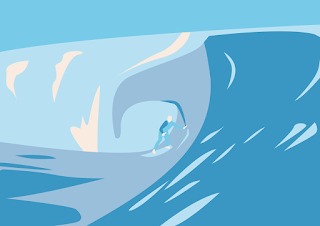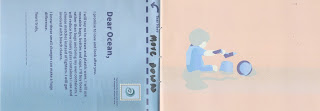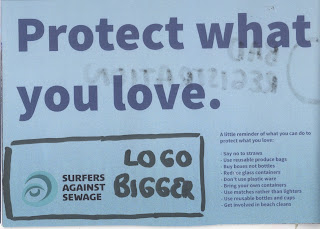OUGD503
SB01
Dropbox - Development
Colour Scheme
Story Board sketches
Visual Research
For this I looked at 1950's and 60's railway posters.
Limiting colour palette to 7 colours per image
Colour Palette
More developed sketches, experimenting with colour pallets. I think the colours move with the story, the lighter warmer colours reflect what people love about the ocean. The darker colours highlight the negative impact plastic pollution is having.
Considering Materials
Colours
Different shades of blue. If the content is showing the damage the
plastic waste causes the colours will be darker. If the content shows the enjoyment
that can be had at the beach the blues will be lighter.
Layout
Story told over pages (traditional layout)
concertina booklet that unfolds to show the story played out in
full.
Materials
Traditional ink
Traditional commercial ink uses petroleum as the medium for
suspended pigmentation. Petroleum-based inks start doing damage long before
they’re thrown away—from the minute they’re laid down on paper, they release
volatile organic compounds (VOC’s) into the air. These chemicals contribute to
global warming and the indoor air pollution in your house and office. They also
harm the environment when they decompose, releasing toxic chemicals into
waterways and the atmosphere.
Water based inks
Traditional water based inks are better for the environment than
solvent based inks because they contain far less VOC's, VOC's are Volatile
Organic Compounds that are released into the atmosphere as the ink dries.
Because water is the main "solvent" in standard water based inks the
VOC level is dramatically reduced making them much better for the environment.
They are however all based on materials that are ultimately derived from
petroleum or have been dug out of the ground (extenders/fillers), this means
they are "exhaustive materials" that will eventually run out.
Soy based ink -
The most common use of soy
oil in ink occurs in offset lithographic ink – the kind most commonly used in
commercial printing. Black offset litho ink must have at least 40 percent soy
oil content to qualify as a soy ink.
“We have reduced our VOC’s 22 percent and HAP’s (hazardous air pollutants) by 93 percent by switching from petroleum-based ink to soy and vegetable ink.”
Issues with soy inks:
Soy is one of the major crops used in
conventional agriculture’s monoculture system, which severely limits
biodiversity and inhibits ecosystem resiliency. Over 90 percent of U.S. soy
fields are planted in genetically modified soy; GMO’s present a range of
environmental concerns. And, the increase in global demand for
soy products contributes to large scale deforestation in the Amazon
rainforest and elsewhere.
On the other hand, soy beans require minimal
chemical input compared to many other crops. There’s no denying that even
vegetable inks containing mineral components are usually far less toxic than
conventional inks. And, veggie inks are proving to be more biodegradable as
well.
Earth Inks -
Earth inks is a business that create high quality inks in a comprehensive
range of colours. Earthinks are glycol and silicone free, contain no heavy
metals and are near zero VOC levels. Every product in the range is based on
natural ingredients such as soy, starch, sugars, dextrin, tree resin, cellulose
and other polysaccharides. Natural waxes are used to replace standard synthetic
grades, and natural oils are used to defoam in place of mineral oils and
silicones, ensuring Earthinks are completely in line with food packaging
regulations.
They are water based, natural printing inks.
The company also runs Planet Earth, an ink management software
that and free ink recycling.
Earthinks are water based inks made from raw materials that can be
replanted or regrown and so are a much more sustainable product for now and the
future and also have the advantage of not being subject to wild fluctuations in
oil price.
Issues with pigment -
Pigments are generally mineral in origin and it’s
not uncommon for them to be toxic. For instance, carbon black is widely used as
the pigment for black ink and is classified as a Group 2B carcinogen. (The
agent (mixture) is "possibly carcinogenic to humans". This
category is used for agents, mixtures and exposure circumstances for which
there is limited evidence of carcinogenicity in humans and less than sufficient
evidence of carcinogenicity in experimental animals.)
Water soluble Paper-
water soluble paper is a unique material which
dissolves completely and rapidly in water along with anything printed or
written on it. The water-soluble paper and tape is cellulose based (finely
ground tree pulp). The paper is non-toxic, biodegradable and 100%
recyclable. Products made of this material will dissolve in any
temperature of water, leaving no residue behind. Agitation (stirring, providing
a forced flow of water) helps to break down the dissolvable fibers. It is 100%
dispersible in water in 30 seconds or less. It is recommended that water
or soy based inks to keep with the solubility of the product, however some
applications do not require this.
 |
| What the Font App |
The closest typefaces were:
Parisine Plus Std Sombre Regular
Asterisk Sans Pro Black Italic
Novel Display Black Condensed
Closest free typefaces:
Parisine
Source Sans Bold Italic
Source Sans Black
Open Sans Condensed Bold
The booklet will contain short instructions about how to reduce plastic pollution
What can WE do?
- Say no to straws
- Use reusable produce bags
- Buy boxes not bottles
- Reduce glass containers
- Don't use plastic ware
- Bring your own containers
- Use matches rather than lighters
- Use reusable bottles and cups
- Get involved in beach cleans
These small changes can make a huge difference
Possible layouts
Adding Texture and Text
Test Print
The test print was unsuccessful, the colours didn't print well. The black writing should be a purple. There are some issues with overlap in the illustrations and the pages didn't print in order or the right way round. The biggest issue is that I set the scale to A5 landscape. I thought this would fit on a A3 but I did not consider crop or bleed. This means I will have to print it on A2 paper or re-scale the booklet to a size smaller than A5. Alternatively the Japanese method of binding can be used so the booklet can be printed on a4 rather than a3. I will have to consider the effect the binding will have in terms of creep.
Title considerations. The title calls the book a love letter, however, it is a booklet. How would I show the booklet as a love letter?
Allow people to actually send a letter to the sea. A rip out page, which encourages people to write a pledge to the sea about how they will reduce their single use plastic usage. The rip out page can be water soluble so it instantly dissolves when in contact with water. This way the letter is literally going to the the ocean. 'A love letter to the ocean.' This also means that people can keep the illustrations to remind them to cut down on their plastic usage.
Changes
- Change the size of Indesign document to something smaller but proportional. Consider bleed.
- make alterations to type and illustration faults.
- Change the information page to a letter, with an explanation that this page can be ripped out and delivered to the ocean.
Test Print 2
In response to the last test print I have made some alterations. I re sized the document to a size that would fit a whole spread on a A3 sized paper, including bleeds and crop marks. I corrected the orientation by making sure a selected the bind short edge option in the printers menu. There are still a few alterations to be made to placement and sizing of some objects and the registration of pages.
The only major alteration was changing the list of things that can be done into a love letter. This made the title more relevant to the product. It is accompanied by a stamp and instructions to rip out the letter and 'deliver' it to the ocean. This means that only one page will be printed on the soluble paper. This will reduce costs and also mean that the rest of the book can be kept as a memento and a reminder. The list of things that can be done to reduce the plastic pollution is repeated on the last page so when the letter has been removed, the list remains. I changed the position of the of the information/letter page to the front of the book as it was important that the narrative stayed in tact without the letter. Remove the cover and first page and the story of the book remains.
Title considerations. The title calls the book a love letter, however, it is a booklet. How would I show the booklet as a love letter?
Allow people to actually send a letter to the sea. A rip out page, which encourages people to write a pledge to the sea about how they will reduce their single use plastic usage. The rip out page can be water soluble so it instantly dissolves when in contact with water. This way the letter is literally going to the the ocean. 'A love letter to the ocean.' This also means that people can keep the illustrations to remind them to cut down on their plastic usage.
Changes
- Change the size of Indesign document to something smaller but proportional. Consider bleed.
- make alterations to type and illustration faults.
- Change the information page to a letter, with an explanation that this page can be ripped out and delivered to the ocean.
Test Print 2
In response to the last test print I have made some alterations. I re sized the document to a size that would fit a whole spread on a A3 sized paper, including bleeds and crop marks. I corrected the orientation by making sure a selected the bind short edge option in the printers menu. There are still a few alterations to be made to placement and sizing of some objects and the registration of pages.
The only major alteration was changing the list of things that can be done into a love letter. This made the title more relevant to the product. It is accompanied by a stamp and instructions to rip out the letter and 'deliver' it to the ocean. This means that only one page will be printed on the soluble paper. This will reduce costs and also mean that the rest of the book can be kept as a memento and a reminder. The list of things that can be done to reduce the plastic pollution is repeated on the last page so when the letter has been removed, the list remains. I changed the position of the of the information/letter page to the front of the book as it was important that the narrative stayed in tact without the letter. Remove the cover and first page and the story of the book remains.




























































No comments:
Post a Comment